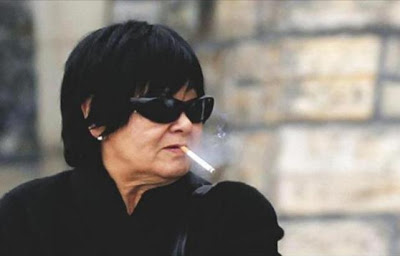From the start, J.M. Barrie's Peter Pan was a character with a massive identity crisis: a boy who doesn't want to grown up, who can fly and whose best friend is a fairy, and who is traditionally played by a female actress in the stage version. So it makes sense that, over the years, Peter has become a creative canvas on which to project other, highly personalized, versions of difference and outsiderness. Perhaps the most extreme example of this was Michael Jackson's attempt to build his own Neverland, and to surround himself with a steady supply of "lost boys."
Local theatre artist Niall McNeil keeps things safely in the realm of make-believe in
Peter Panties, a new musical play that opens at the
Cultch's Historic Theatre tonight in a co-production between
Neworld Theatre and
Leaky Heaven Circus, and co-presented by the Cultch and the
PuSh Festival. I caught a preview performance last night, and it was a most surreal experience. Working with co-writer Marcus Youssef, McNeil has used his own longstanding fascination with and interpretive deconstruction of the Peter Pan story to craft a pop-culture mash-up for our cynical, forensic (there is a CSI intertext) twenty-first century that nevertheless retains the sense of wonder and mythic possibility that was such a key element of the original story.
In Peter Panties, an oversexed Peter very much wants to grow up, settle down, and have a kid with Wendy (though there also seems to be a noticeable sexual frisson between Peter and Wendy's mother, Mrs. Darling). Tinkerbell, meanwhile, has a hate-on for Wendy, and seems to be working in cahoots with Hook and Starkey to see that she ends up dead. As for Wendy, who emerges as the protagonist of this story, her narrative arc appears to be one of increasing dis-enchantment: with her dull life at home chez Mother Darling; with the dreamworld of Neverland, which subjects her to violence and abduction; and with her fairytale marriage to Peter--which turns out to be just that, a fairytale, and which furthermore leaves her a young, single mother. Indeed, watching this Wendy I was very much put in mind of Joyce Carol Oates' teenage protagonist Connie, from her famous story "Where Are You Going? Where Have You Been?" However, unlike the moral allegory at work in Oates' story, Peter Panties remains at heart a comic fantasy and so, true to form, we end on an upswing, with a second marriage for the resurrected Wendy--this time to Niall himself. Peter is left picking at his green tights back in Neverland.
Overall, the production is pervaded by a sense of wonderfully anarchic chaos. It is less about retelling the Peter Pan story in a straight-up, comprehensible way than examining the creative process of storytelling itself. To this end, we hear in voice-over before the house lights go down McNeil and Youssef talking through their ideas for the play, exchanges that are later projected in video format on a white sheet. And a recurring refrain among several characters is what happens backstage, including, we are led to believe, some creative workings through of creative differences. Banquo's ghost, escaped from the Scottish play, also serves as a metatheatrical reference point in this regard.
Indeed, for me this play is mostly a love letter to the magic of the theatre, a magic that is all about showing the wires, and making do with what is at hand, but that nevertheless thrills and astounds because, together, we choose to believe (however tenuously or temporarily) in the power of this magic. And, here, director Steven Hill does not disappoint: the coups-de-théâtre in this show are achieved so simply (Tinkerbell holding Peter's cape while he flies past Mrs. Darling's window, Wendy and a mermaid duking it out in a shadow boxing match), but are no less gasp-inducing because of that.
Not everything in the production had gelled by last night: the pacing was slow to begin with; it was hard to hear what Veda Hille and her band, The Bark Dogs, were singing at times; and I'm not sure the lighting design, which keeps too many characters in too many scenes in semi-darkness for too long, completely works. That said, I had great fun, and I'm sure things will only get tighter over the course of the play's run.
That run in fact extends beyond the end of the PuSh Festival, to February 13th.
P.




